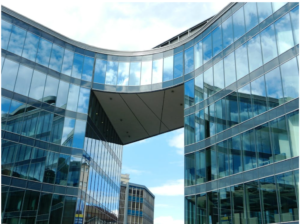
A long-used statistic in the wireless industry is that 80% of mobile interactions occur indoors, so building owners are acutely aware when they provide insufficient coverage to occupants. Concrete, steel, and low-E glass keep public cellular services from providing sufficient coverage and capacity inside large buildings, so internal methods are required. Neutral host networks are often an excellent way to provide cellular coverage inside office buildings, venues, shopping malls, airports, and other places where people congregate in large numbers. However, they can be expensive, so building owners continually look for ways to cost-effectively provide ubiquitous indoor and outdoor connectivity.
There were two common ways of providing a neutral host network. One is with operator-specific small cells, which provide sufficient coverage for its users, but each is an independent network with its own cabling, backhaul, etc. It increases the hardware necessary and accompanying costs in a building if coverage is desired for multiple operators. The more common solution is DAS (Digital Antenna Systems), which is carrier-agnostic and well-suited for large facilities but is prohibitively expensive for small and medium-sized buildings.
The Advantages of Using CBRS in Neutral Host Networks
CBRS (Citizens Broadband Radio Service) offers building owners two powerful means of keeping costs down for a neutral host network: access to low-cost spectrum and carrier-agnostic cellular infrastructure.

CBRS enables shared spectrum access, allowing multiple operators to use the same spectrum band for their services. CBRS is available in many areas for no cost, with General Authorized Access (GAA) available if no one in the area has a license, which in practice is quite often.
Using the CBRS band also allows building owners to use carrier-agnostic cellular infrastructure. In the picture, the Shared Radio Access Network (RAN) refers to the common hardware that communicates with all user devices, regardless of carrier. A 3GPP-based architecture using Multi-Operator Core Network (MOCN) is commonly used to connect to the various operator networks. This approach reduces costs and provides continuous connectivity to users.
A CBRS-based neutral host network can also be deployed in a fraction of the time it takes to install the equipment necessary for alternative approaches.
CBRS Makes Financial Sense for Building Owners
The OnGo Alliance has described several appropriate CBRS-based Neutral Host Networks business models. These include:
- Model-1: OnGo NHN-as-a-Service, which is run by a Neutral Host Operator who runs the building’s network, minimizing the need for the building owner to have network expertise and providing flexibility for payment options. This will likely be the most popular model initially.
- Model-2: Building owned, managed, and operated: In this model, buildings take full responsibility for all aspects of the neutral host network, allowing them complete control of all services and the choice to use existing infrastructure, reducing CapEx.
- Model-3: The hybrid model sees the building maintaining ownership of the network while outsourcing operations and management. This choice lets building owners use the providers’ resources while maintaining direct control of service quality.
source: OnGo-NHN-Business-Update-Final-2021-11.pdf (ongoalliance.org)
Meta Uses CBRS for Neutral Host Networks Across the Company
Meta has approximately 20 million square feet of office space in the US alone, and DAS is currently in 30% of the area. Meta wanted to find a standard solution they could roll out across all their buildings and handle roughly a dozen private use cases. They needed something scalable and future-proofed and wanted to work with the mobile network operators.
Meta decided to deploy a CBRS-based neutral host network and collaborated with AT&T, Verizon, and T-Mobile for coverage in their facilities. Meta found that in their traditional open floorplans, they could deploy a CBRS-based network 75% faster than a DAS deployment, with significant cost savings, and get consistent coverage in all their buildings. As they plan to scale this solution across hundreds of properties, they see the opportunity for high savings.
The operators worked through substantial challenges, including regulatory requirements, such as E911 and CALEA, which were covered, working with non-traditional MNO radios and integrating them into all their networks. By taking a collaborative approach, Meta brought the three MNOs together to solve a real-world problem, which worked exceedingly well.
Meta described the overall solution as a win-win-win, as the operators benefit by having expanded coverage in the buildings, Meta gains by providing a great office experience and having the new networks deployed more quickly, and their employees gain by having strong coverage and capacity in all their facilities.
The Future of CBRS and Neutral Host Networks
Neutral host networks provide a cost-effective solution for deploying and maintaining multi-operator wireless infrastructure. With the availability of the CBRS band, neutral host networks can now provide cost-effective shared infrastructure for multiple carriers and enterprises, enabling better indoor coverage for public cellular networks and private LTE/5G networks for a variety of customers, building types, and use cases.
